Massage Products Business Plan
Massage Tools Products Inc. sells massage tools to the professional and retail markets. Our products address chronic overuse injuries and discomfort experienced by busy massage therapy professionals. Designed with the massage therapist in mind, Massage Tool Products’ unique ergonomic shape allows for targeted pressure application with less hand and wrist strain. Ideal for trigger point, deep tissue, reflexology, seated massage, or any modality, this product fulfills the needs of healthcare professionals limited by injury interruptions.
This business plan guides our company’s internal use as we launch and aim for growth. We will refer to it quarterly to track performance against our plans and adjust accordingly.
Massage Tools Products has experienced growth in the professional massage therapy market, thanks to advertising appearances in trade publications and end-user magazines, as well as our website.
This annual business plan outlines a year of gradual growth, followed by a year of rapid sales increase. The break-even analysis shows that Massage Tools has a healthy balance of fixed costs and sales strength. Our break-even point for the first year is just over $6,000 per month.
We also anticipate increased profitability. Overall, the outlook shows a healthy company with promising growth prospects, focused on managing orderly growth in the future.
1.1 Mission
Massage Tools Products Inc. aims to provide top-quality massage tools that enhance the effectiveness of massage therapists and reduce repetitive use injuries.
1.2 Keys to Success
- Low assembly costs
- Favorable profit margins
- Innovative market leader in massage tools
- Low overhead
1.3 Objectives
Get Massage Tools’ product line into 100 retail stores and massage therapy schools across the United States.
Create a website with online ordering capability for Massage Tools’ product line.
Develop additional products within 18 months to increase market share.
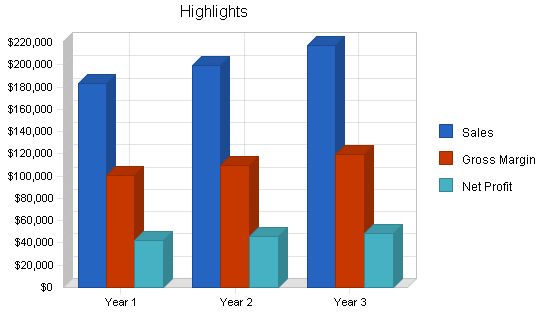
Company Summary
Massage Tools Products Inc. is a start-up business established in Eugene, Oregon in October 2002. We sell Massage Tools to both the professional and retail market. Our products are designed to address chronic overuse injuries and discomfort experienced by busy massage therapy professionals. Massage Tools can be used for massage therapy in place of or in addition to a therapist’s hands to provide sufficient pressure for therapeutic massage. This product fills the need of health care professionals whose careers are limited by their ability to serve multiple clients a day without interruption by injury.
2.1 Start-up Summary
Our start-up costs total $19,300, primarily insurance and product development, legal costs, and expenses associated with opening our office. The costs will be financed by direct owner investment and a $15,000 line of credit with the bank. The assumptions are shown in the table and illustration below.
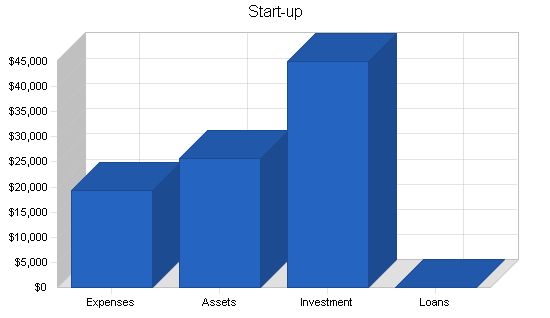
Start-up Funding
Start-up Expenses to Fund: $19,300
Start-up Assets to Fund: $25,700
Total Funding Required: $45,000
Assets
Non-cash Assets from Start-up: $13,000
Cash Requirements from Start-up: $12,700
Additional Cash Raised: $0
Cash Balance on Starting Date: $12,700
Total Assets: $25,700
Liabilities and Capital
Liabilities
Current Borrowing: $0
Long-term Liabilities: $0
Accounts Payable (Outstanding Bills): $0
Other Current Liabilities (interest-free): $0
Total Liabilities: $0
Capital
Planned Investment:
Ron Tickman: $40,000
Investor 2: $5,000
Additional Investment Requirement: $0
Total Planned Investment: $45,000
Loss at Start-up (Start-up Expenses): ($19,300)
Total Capital: $25,700
Total Capital and Liabilities: $25,700
Total Funding: $45,000
Start-up Requirements
Start-up Expenses
Legal: $750
Stationery etc.: $1,500
Brochures: $2,500
Consultants: $1,000
Insurance: $5,000
Rent: $850
Research and Development: $6,500
Expensed Equipment: $1,200
Total Start-up Expenses: $19,300
Start-up Assets
Cash Required: $12,700
Start-up Inventory: $8,000
Other Current Assets: $5,000
Long-term Assets: $0
Total Assets: $25,700
Total Requirements: $45,000
2.2 Company Ownership
Massage Tools Products Inc. is a privately owned, C-corporation with a single owner.
Products
Designed with the massage therapist in mind, Massage Tool Products’ unique ergonomic shape gives you the leverage to apply pressure where needed with less hand and wrist strain. Ideal for trigger point, deep tissue, reflexology, seated massage, or practically any modality. The smooth contoured shape glides easily over clothing or on skin with oils or lotions. Save your hands – and your career with Massage Tools.
Massage Tool – $14.50
Massage Tool Deluxe – $16.50
Market Analysis Summary
We intend to appeal to the professional massage therapist and the massage school market. This market segment appreciates and truly needs the Massage Tool Products line.
In our market, we also seek the end user who appreciates the advantage of having professional quality tools.
4.1 Target Market Segment Strategy
Massage therapists are generally exposed to tools and equipment through their school. Their instructors have credibility, and the products they endorse are generally the ones the students buy. Increasingly, massage therapists are looking for products to extend their productivity and the length of their career by avoiding overuse injuries. Our product addresses this critical need, and we’ll buy visibility in Massage Magazine and with schools across the U.S. and in Europe and Japan, which are the primary markets. Gradually, we will also move into China.
4.2 Market Segmentation
Massage Tools Products Inc. sells Massage Tools to both the professional and retail market. Our products address the chronic overuse injuries and discomfort experienced by busy massage therapy professionals. Designed with the massage therapist in mind, Massage Tool Products’ unique ergonomic shape gives you the leverage to apply pressure where needed with less hand and wrist strain. Ideal for trigger point, deep tissue, reflexology, seated massage, or practically any modality, this product fills the need of a growing group of health care professionals whose careers are limited by their ability to serve multiple clients a day without interruption by injury.
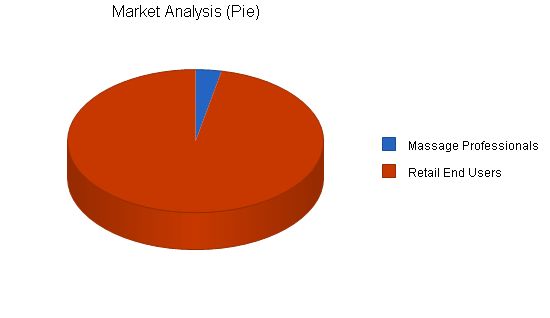
Market Analysis:
Year 1 Year 2 Year 3 Year 4 Year 5
Potential Customers Growth CAGR
Massage Professionals 8% 40,000 43,200 46,656 50,388 54,419 8.00%
Retail End Users 2% 1,200,000 1,224,000 1,248,480 1,273,450 1,298,919 2.00%
Total 2.21% 1,240,000 1,267,200 1,295,136 1,323,838 1,353,338 2.21%
The massage therapy industry has undergone significant change in the last five years. Many larger manufacturers of tables and chairs have gone out of business, as they were competing primarily on price. The remaining companies are known for their quality workmanship and money-back guarantees.
Existing companies in the massage professionals niche are offering various products and tools, but none have a tool like ours that specifically addresses overuse injuries.
Our product line fills a niche that is just beginning to open up. The boom in massage therapy over the last 15 years has led to a significant number of professional massage therapists experiencing carpal tunnel syndrome or other overuse injuries. Our products are designed to assist these professionals and extend their careers. New professionals, who have just completed their education, will understand the importance of purchasing and using Massage Tools Products as they start building their practices, having witnessed industry trends.
Most graduating massage therapists are women aged 23-35, aiming to serve multiple clients a day to generate sufficient income. They tend to purchase from their massage schools or associated stores. We have connections with these schools, as well as several physical therapy schools through our affiliation with a massage table company. It will be a natural choice for these schools and stores to add our product to their line.
4.3.1 Competition and Buying Patterns
Newcomers to the U.S. market include Chinese and European manufacturers. Their products are incredibly inexpensive but lack stellar quality, though they continue to improve.
Strategy and Implementation Summary
We focus on a special customer segment: professionally trained massage therapists and the schools that train them. Important factors for customers include performance, affordability, beauty, ease of use, ergonomics, and practicality.
Our marketing strategy involves targeting specialty channels to meet our customers’ needs. Our key competitive advantage is our positioning with massage schools, so that our customers are exposed to our products before they start their professional career and while they are in the process of purchasing equipment to begin their practice.
5.1 Competitive Edge
Our competitive edge lies in our innovation of offering a product that fulfills a tremendous need among professional massage therapists, a product that has never been offered before.
To develop effective business strategies, conduct a SWOT analysis of your business. Our free guide and template will help you perform a SWOT analysis.
5.2 Marketing Strategy
We focus on the massage school and massage student market segment. Massage therapists are typically introduced to tools and equipment through their schools, and they tend to purchase products endorsed by their instructors. More and more, massage therapists are seeking products that help prevent overuse injuries and extend their careers. Our product addresses this critical need. We will increase our visibility through advertisements in Massage Magazine and partnerships with schools across the U.S., Europe, and Japan, which are our primary markets. We will gradually expand into China.
5.3 Sales Strategy
Our strategy involves first getting our product into massage therapy schools and retail health and wellness stores, and then reaching end users through online sales on our website.
In 2004, we plan to expand our focus to include high-end direct mail catalogs catering to high net worth individuals who have discretionary income to spend on personal health and wellness products. The Spa and Resort retail stores are also a potential channel for us.
5.3.1 Sales Forecast
Our sales forecast assumes a gradual increase in costs with no change in prices. However, pricing may increase based on market reception and the presence of competing products.
We project conservative growth in our first year, with no significant changes in the product line.
Our business experiences seasonality, with better sales in spring and fall, and lower sales in summer due to fewer students enrolled in massage schools. However, we can expect some increase in retail sales during the Christmas holiday season.
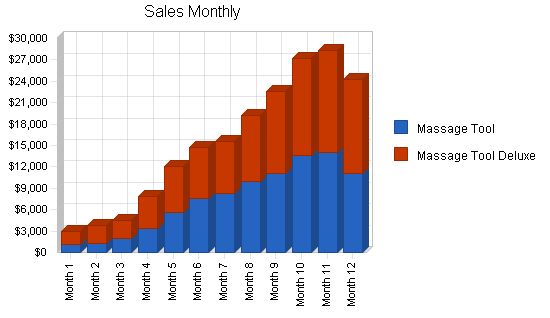
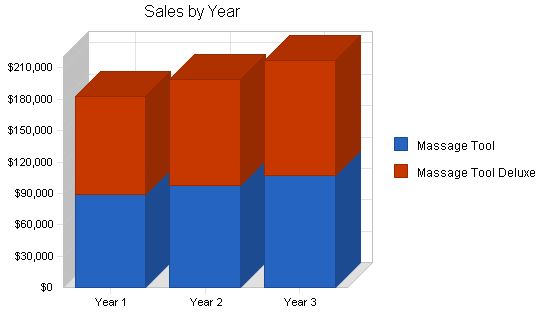
Sales Forecast:
| Sales Forecast | |||
| Year 1 | Year 2 | Year 3 | |
| $88,832 | $97,715 | $107,487 | |
| $94,108 | $101,637 | $109,768 | |
| $182,940 | $199,352 | $217,254 | |
| $44,416 | $48,858 | $53,743 | |
| $37,643 | $40,655 | $43,907 | |
| $82,059 | $89,512 | $97,650 | |
5.4 Milestones
The table shows specific milestones, assigned responsibilities, dates, and (in most cases) budgets. This plan focuses on key milestones that should be accomplished.
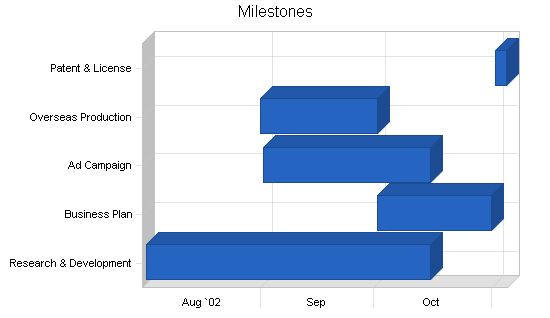
Milestones:
| Milestone | Start Date | End Date | Budget | Manager | Department |
| Research & Development | 8/1/2002 | 10/15/2002 | $3,000 | Ron Tickman | Marketing |
| Business Plan | 10/1/2002 | 10/31/2002 | $800 | Katherine Allen | Marketing |
| Ad Campaign | 9/1/2002 | 10/15/2002 | $1,500 | Jerril Nelson | Web |
| Overseas Production | 8/31/2002 | 10/1/2002 | $5,000 | Steve Kippman | Web |
| Patent & License | 11/1/2002 | 11/31/02 | $250 | Ron Tickman | Marketing |
| Totals | $10,550 |
Web Plan Summary:
The Massage Tools website will provide a platform for purchasing our product line. We will also include content that explains overuse injuries for massage professionals and a self-test to determine if users are prone to such injuries due to their workload.
We have a user-friendly shopping cart feature to ensure a quick and easy purchasing process. We understand that a complicated ordering procedure can discourage potential customers.
MassageTools.com may collaborate with online massage retailers to offer complementary products such as oils, lotions, sheets, pillows, and aromatherapy.
6.1 Website Marketing Strategy
Our internet marketing activities will focus on product sales. While we will also sell to massage schools and resellers, our main target audience will be the general public end user.
We will advertise the website in non-trade publications like New Age, Health, Simple, and Self.
6.2 Development Requirements
The Massage Tools website will initially be developed with minimal technical resources. Jurgens Information Services, a local hosting provider, will host the site and provide the technical back end. They will also contract user interface design services to develop a simple site. The user interface designer will collaborate with a graphic artist to create the website logo and graphics.
Jurgens consultants will handle site maintenance. We do not anticipate significant changes until additional products are developed.
Management Summary:
We are a small LLC owned and operated by Ron Tickman. Ron is the developer, designer, and president of Massage Tools Products.
As our product line expands beyond the massage industry and targets the general public, our personnel plan includes increasing the number of sales representatives from one to two in three years.
We will primarily process orders via fax or online. Therefore, we will continue to outsource fulfillment, shipping, packaging, and call services to a local call center.
7.1 Personnel Plan
The president will receive a small stipend in the first year to reinvest the majority of the profits.
The sales representative will have a base salary aligned with market pay in the Eugene area. The remainder of her salary will be based on a percentage of gross sales.
| Personnel Plan | |||
| Year 1 | Year 2 | Year 3 | |
| Ron Tickman, President & Owner | $1,200 | $2,500 | $2,500 |
| Katherine Allen, Sales Rep | $4,500 | $6,500 | $7,500 |
| Other | $0 | $0 | $0 |
| Total People | 0 | 0 | 0 |
| Total Payroll | $5,700 | $9,000 | $10,000 |
The financial outlook is positive. We have been cautious in taking on debt, and our credit line with the bank is backed by assets.
8.1 Important Assumptions
The financial plan is based on important assumptions, many of which are outlined in the table below. The key assumptions include:
- We anticipate a slow-growth economy without significant recessions.
- We have access to equity capital and financing to support our financial plan.
| General Assumptions | |||
| Year 1 | Year 2 | Year 3 | |
| Plan Month | 1 | 2 | 3 |
| Current Interest Rate | 10.00% | 10.00% | 10.00% |
| Long-term Interest Rate | 10.00% | 10.00% | 10.00% |
| Tax Rate | 30.00% | 30.00% | 30.00% |
| Other | 0 | 0 | 0 |
8.2 Break-even Analysis
According to the break-even analysis, Massage Tools has a balanced structure of fixed costs and strong sales potential, ensuring a healthy financial state. Our break-even point for the first year is just over $6,000 per month.
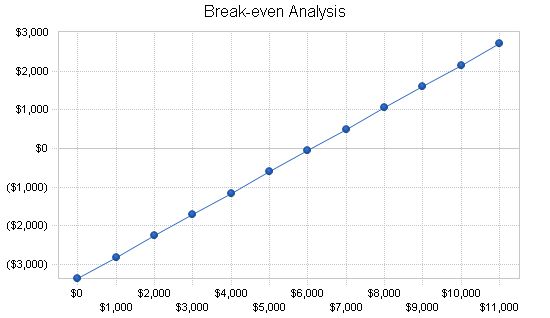
Break-even Analysis
Monthly Revenue Break-even: $6,090.
Assumptions:
– Average Percent Variable Cost: 45%
– Estimated Monthly Fixed Cost: $3,359.
Projected Profit and Loss:
We anticipate a substantial increase in profitability in the coming years as we establish a strong presence in the market. Our higher sales volume will reduce costs and improve our gross margin, thereby enhancing overall profitability.
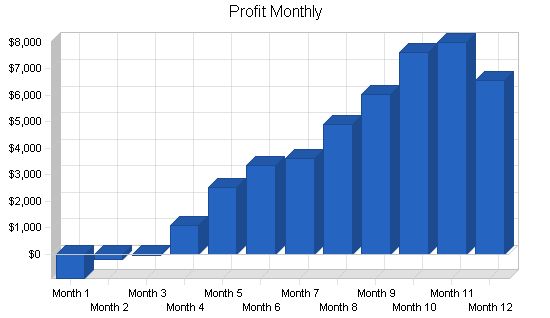
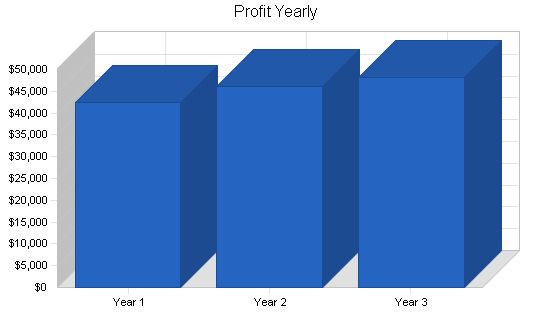
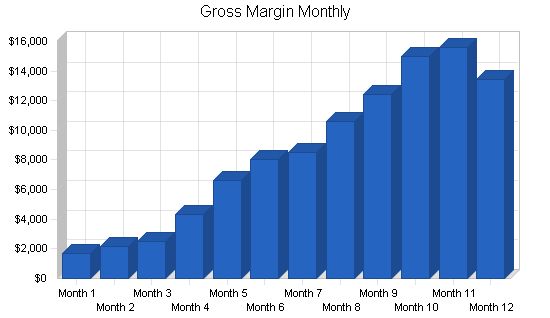
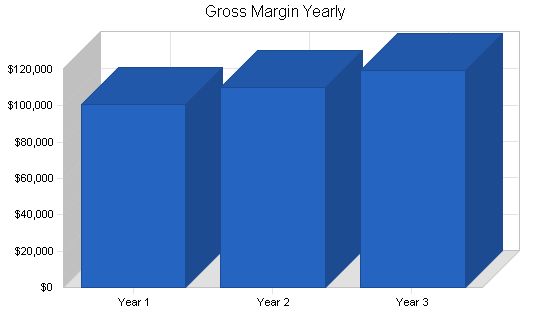
Pro Forma Profit and Loss
Year 1 Year 2 Year 3
Sales $182,940 $199,352 $217,254
Direct Cost of Sales $82,059 $89,512 $97,650
Other Costs of Goods $11 $0 $0
Total Cost of Sales $82,070 $89,512 $97,650
Gross Margin $100,870 $109,840 $119,604
Gross Margin % 55.14% 55.10% 55.05%
Expenses
Payroll $5,700 $9,000 $10,000
Sales and Marketing and Other Expenses $7,800 $9,500 $12,500
Depreciation $0 $0 $0
Rent $10,200 $7,200 $8,500
Utilities $2,400 $2,800 $3,200
Insurance $4,200 $4,750 $5,000
Payroll Taxes $855 $1,350 $1,500
Commission $9,147 $9,968 $10,863
Total Operating Expenses $40,302 $44,568 $51,563
Profit Before Interest and Taxes $60,568 $65,272 $68,041
EBITDA $60,568 $65,272 $68,041
Interest Expense ($163) ($450) ($750)
Taxes Incurred $18,219 $19,717 $20,637
Net Profit $42,511 $46,005 $48,154
Net Profit/Sales 23.24% 23.08% 22.16%
8.4 Projected Cash Flow
We expect to manage cash flow over the next three years with new investment this year. Additional financing resources are required to finance the working capital of a growing business. However, the investment is small due to the low overhead.
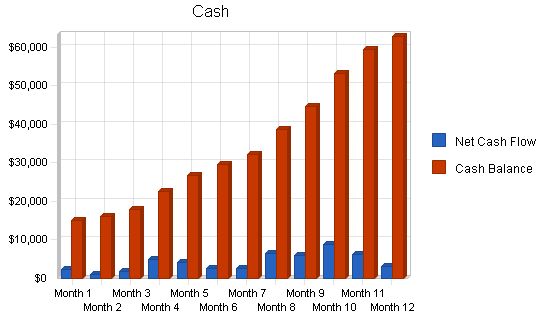
Pro Forma Cash Flow
| Pro Forma Cash Flow | |||
| Year 1 | Year 2 | Year 3 | |
| Cash Received | |||
| Cash from Operations | |||
| Cash Sales | $182,940 | $199,352 | $217,254 |
| Subtotal Cash from Operations | $182,940 | $199,352 | $217,254 |
| Additional Cash Received | |||
| Sales Tax, VAT, HST/GST Received | $0 | $0 | $0 |
| New Current Borrowing | $0 | $0 | $0 |
| New Other Liabilities (interest-free) | $0 | $0 | $0 |
| New Long-term Liabilities | $0 | $0 | $0 |
| Sales of Other Current Assets | $0 | $0 | $0 |
| Sales of Long-term Assets | $0 | $0 | $0 |
| New Investment Received | $0 | $0 | $0 |
| Subtotal Cash Received | $182,940 | $199,352 | $217,254 |
| Expenditures | |||
| Expenditures from Operations | |||
| Cash Spending | $5,700 | $9,000 | $10,000 |
| Bill Payments | $124,321 | $147,772 | $159,059 |
| Subtotal Spent on Operations | $130,021 | $156,772 | $169,059 |
| Additional Cash Spent | |||
| Sales Tax, VAT, HST/GST Paid Out | $0 | $0 | $0 |
| Principal Repayment of Current Borrowing | $3,000 | $3,000 | $3,000 |
| Other Liabilities Principal Repayment | $0 | $0 | $0 |
| Long-term Liabilities Principal Repayment | $0 | $0 | $0 |
| Purchase Other Current Assets | $0 | $0 | $0 |
| Purchase Long-term Assets | $0 | $0 | $0 |
| Dividends | $0 | $0 | $0 |
| Subtotal Cash Spent | $133,021 | $159,772 | $172,059 |
| Net Cash Flow | $49,919 | $39,580 | $45,195 |
| Cash Balance | $62,619 | $102,198 | $147,394 |
8.5 Projected Balance Sheet
Although we will not begin making a profit until April of this year, we are pleased that we will begin to recoup our investment in only four months. The critical piece of this success is the large margin on each product sold as well as the low operational expenses.
| Pro Forma Balance Sheet | |||
| Year 1 | Year 2 | Year 3 | |
| Assets | |||
| Current Assets | |||
| Cash | $62,619 | $102,198 | $147,394 |
| Inventory | $11,891 | $12,971 | $14,150 |
| Other Current Assets | $5,000 | $5,000 | $5,000 |
| Total Current Assets | $79,510 | $120,169 | $166,544 |
| Long-term Assets | $0 | $0 | $0 |
| Total Assets | $79,510 | $120,169 | $166,544 |
| Liabilities and Capital | Year 1 | Year 2 | Year 3 |
| Current Liabilities | |||
| Accounts Payable | $14,298 | $11,953 | $13,174 |
| Current Borrowing | ($3,000) | ($6,000) | ($9,000) |
| Other Current Liabilities | $0 | $0 | $0 |
| Subtotal Current Liabilities | $11,298 | $5,953 | $4,174 |
| Long-term Liabilities | $0 | $0 | $0 |
| Total Liabilities | $11,298 | $5,953 | $4,174 |
| Paid-in Capital | $45,000 | $45,000 | $45,000 |
| Retained Earnings | ($19,300) | $23,211 | $69,217 |
| Earnings | $42,511 | $46,005 | $48,154 |
| Total Capital | $68,211 | $114,217 | $162,370 |
| Total Liabilities and Capital | $79,510 | $120,169 | $166,544 |
| Net Worth | $68,211 | $114,217 | $162,370 |
8.6 Business Ratios
Standard business ratios for Health and Personal Care Stores (SIC 5047) are included in the following table. The ratios show a plan for balanced, healthy growth. Our return on sales and return on assets remain strong as ever, actually increasing in percentage terms by the same year.
| Ratio Analysis | ||||
| Year 1 | Year 2 | Year 3 | Industry Profile | |
| Sales Growth | 0.00% | 8.97% | 8.98% | 6.98% |
| Percent of Total Assets | ||||
| Inventory | 14.96% | 10.79% | 8.50% | 39.84% |
| Other Current Assets | 6.29% | 4.16% | 3.00% | 22.68% |
| Total Current Assets | 100.00% | 100.00% | 100.00% | 91.25% |
| Long-term Assets | 0.00% | 0.00% | 0.00% | 8.75% |
| Total Assets | 100.00% | 100.00% | 100.00% | 100.00% |
| Current Liabilities | ||||
| Accounts Payable | 14.21% | 4.95% | 2.51% | 37.11% |
| Long-term Liabilities | 0.00% | 0.00% | 0.00% | 10.41% |
| Total Liabilities | 14.21% | 4.95% | 2.51% | 47.52% |
| Net Worth | 85.79% | 95.05% | 97.49% | 52.48% |
| Percent of Sales | ||||
| Sales | 100.00% | 100.00% | 100.00% | 100.00% |
| Gross Margin | 55.14% | 55.10% | 55.05% | 30.78% |
| Selling, General & Administrative Expenses | 31.96% | 32.18% | 33.13% | 15.53% |
| Advertising Expenses | 0.00% | 0.00% | 0.00% | 1.18% |
| Profit Before Interest and Taxes | 33.11% | 32.74% | 31.32% | 2.01% |
| Main Ratios | ||||
| Current | 7.04 | 20.19 | 39.90 | 2.24 |
| Quick | 5.98 | 18.01 | 36.51 | 0.99 |
| Total Debt to Total Assets | 14.21% | 4.95% | 2.51% | 52.38% |
| Pre-tax Return on Net Worth | 89.03% | 57.54% | 42.37% | 6.06% |
| Pre-tax Return on Assets | 76.38% | 54.69% | 41.31% | 12.72% |
| Additional Ratios | Year 1 | Year 2 | Year 3 | |
| Net Profit Margin | 23.24% | 23.08% | 22.16% | n.a |
| Return on Equity | 62.32% | 40.28% | 29.66% | n.a |
| Activity Ratios | ||||
| Inventory Turnover | 9.88 | 7.20 | 7.20 | n.a |
| Accounts Payable Turnover | 9.69 | 12.17 | 12.17 | n.a |
| Payment Days | 27 | 33 | 29 | n.a |
| Total Asset Turnover | 2.30 | 1.66 | 1.30 | n.a |
| Debt Ratios | ||||
| Debt to Net Worth | 0.17 | 0.05 | 0.03 | n.a |
| Current Liab. to Liab. | 1.00 | 1.00 | 1.00 | n.a |
| Liquidity Ratios | ||||
| Net Working Capital | $68,211 | $114,217 | $162,370 | n.a |
| Interest Coverage | 0.00 | 0.00 | 0.00 | n.a |
| Additional Ratios | Year 1 | Year 2 | Year 3 | |
| Pro Forma Balance Sheet | |||||||||||||
| Month 1 | Month 2 | Month 3 | Month 4 | Month 5 | Month 6 | Month 7 | Month 8 | Month 9 | Month 10 | Month 11 | Month 12 | ||
| Assets | Starting Balances | ||||||||||||
| Cash | $12,700 | $15,119 | $16,073 | $17,855 | $22,662 | $26,792 | $29,510 | $32,106 | $38,553 | $44,549 | $53,268 | $59,419 | $62,619 |
| Inventory | $8,000 | $6,715 | $5,051 | $3,067 | $3,804 | $5,910 | $7,280 | $7,746 | $9,570 | $11,141 | $13,475 | $14,024 | $11,891 |
| Other Current Assets | $5,000 | $5,000 | $5,000 | $5,000 | $5,000 | $5,000 | $5,000 | $5,000 | $5,000 | $5,000 | $5,000 | $5,000 | $5,000 |
| Total Current Assets | $25,700 | $26,833 | $26,125 | $25,923 | $31,466 | $37,702 | $41,790 | $44,851 | $53,123 | $60,690 | $71,743 | $78,443 | $79,510 |
| Long-term Assets | |||||||||||||
| Long-term Assets | $0 | $0 | $0 | $0 | $0 | $0 | $0 | $0 | $0 | $0 | $0 | $0 | $0 |
| Accumulated Depreciation | $0 | $0 | $0 | $0 | $0 | $0 | $0 | $0 | $0 | $0 | $0 | $0 | $0 |
| Total Long-term Assets | $0 | $0 | $0 | $0 | $0 | $0 | $0 | $0 | $0 | $0 | $0 | $0 | $0 |
| Total Assets | $25,700 | $26,833 | $26,125 | $25,923 | $31,466 | $37,702 | $41,790 | $44,851 | $53,123 | $60,690 | $71,743 | $78,443 | $79,510 |
| Liabilities and Capital | Month 1 | Month 2 | Month 3 | Month 4 | Month 5 | Month 6 | Month 7 | Month 8 | Month 9 | Month 10 | Month 11 | Month 12 | |
| Current Liabilities | |||||||||||||
| Accounts Payable | $0 | $2,302 | $2,061 | $2,165 | $6,862 | $10,835 | $11,810 | $11,501 | $15,130 | $16,905 | $20,582 | $19,547 | $14,298 |
| Current Borrowing | $0 | ($250) | ($500) | ($750) | ($1,000) | ($1,250) | ($1,500) | ($1,750) | ($2,000) | ($2,250) | ($2,500) | ($2,750) | ($3,000) |
| Other Current Liabilities | $0 | $0 | $0 | $0 | $0 | $0 | $0 | $0 | $0 | $0 | $0 | $0 | $0 |
| Subtotal Current Liabilities | $0 | $2,052 | $1,561 | $1,415 | $5,862 | $9,585 | $10,310 | $9,751 | $13,130 | $14,655 | $18,082 | $16,797 | $11,298 |
| Long-term Liabilities | $0 | $0 | $0 | $0 | $0 | $0 | $0 | $0 | $0 | $0 | $0 | $0 | $0 |
| Total Liabilities | $0 | $2,052 | $1,561 | $1,415 | $5,862 | $9,585 | |||||||
Hello!
I’m Andrew Brooks, a seasoned finance consultant from the USA and the mind behind phonenumber247.com.
My career is built on a foundation of helping individuals and businesses thrive financially in an ever-changing economic landscape. At phonenumber247.com, my aim is to demystify the complex world of finance, providing clear, actionable advice that can help you navigate your financial journey with confidence. Whether it’s personal finance management, investment strategies, or understanding the nuances of market dynamics, I’m here to share insights and tools that can propel you towards your financial goals.
Welcome to my digital space, where every piece of advice is a step closer to financial clarity and success!

